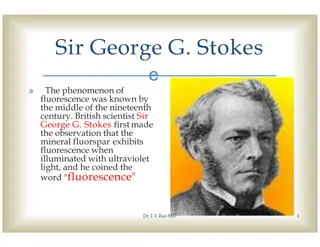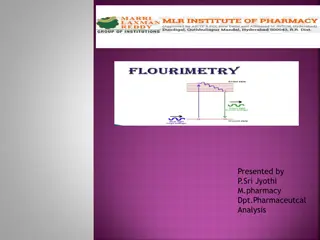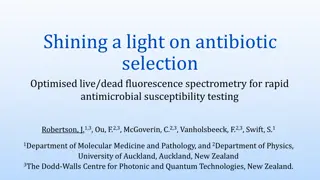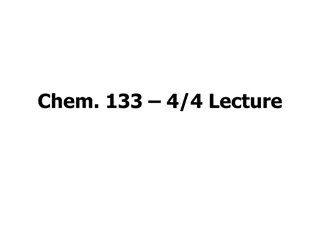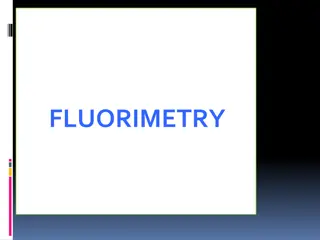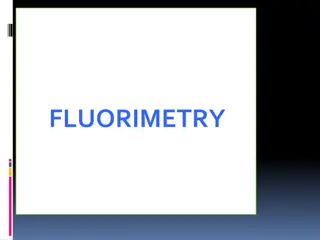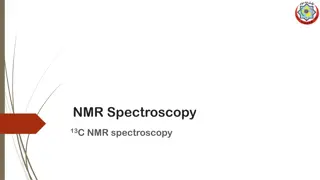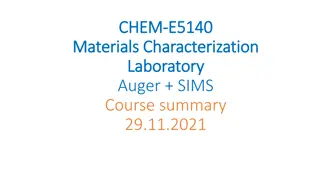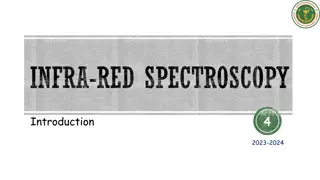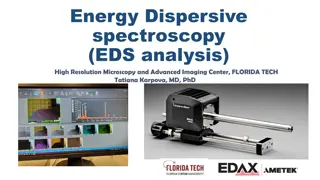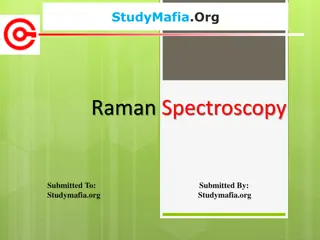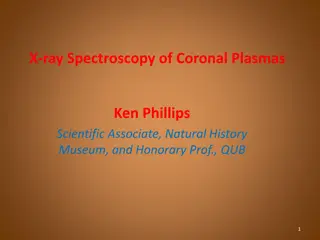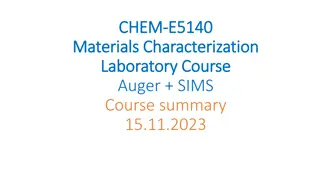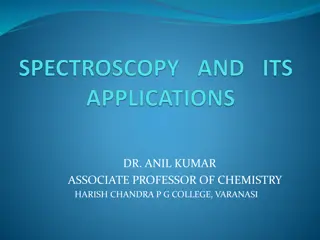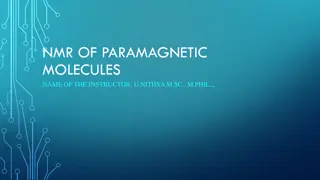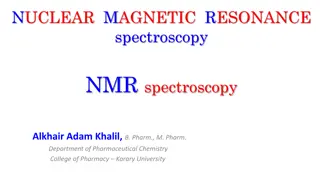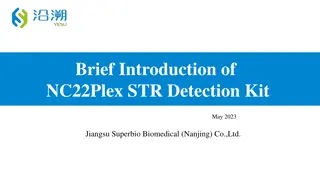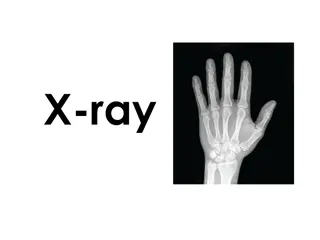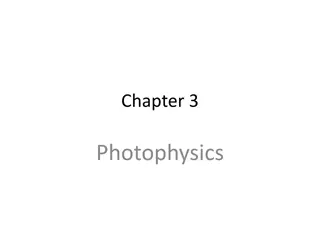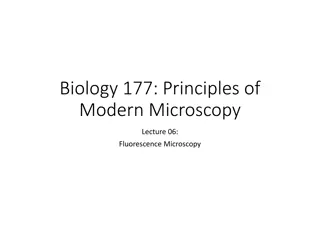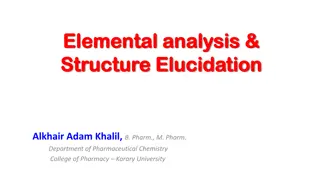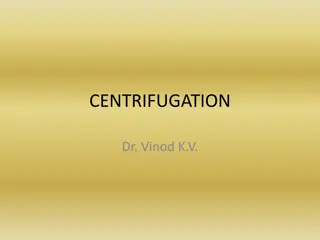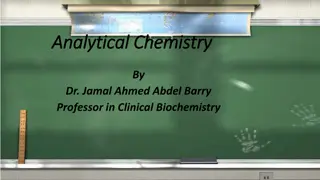Applications and Importance of X-ray Fluorescence Spectroscopy in Analytical Chemistry
X-ray Fluorescence Spectroscopy (XRF) is a vital analytical technique used for qualitative and quantitative analysis of elements based on their X-ray emission characteristics. Dr. Uma Sharma, a Professor at Vikram University, details various X-ray analytical methods, including X-ray emission, Auger emission, and X-ray absorption. X-ray line spectra, secondary fluorescence sources, and emission lines for typical elements are explained. The technique is highlighted as a powerful tool for elemental analysis in chemistry and biochemistry.
Download Presentation

Please find below an Image/Link to download the presentation.
The content on the website is provided AS IS for your information and personal use only. It may not be sold, licensed, or shared on other websites without obtaining consent from the author. Download presentation by click this link. If you encounter any issues during the download, it is possible that the publisher has removed the file from their server.
E N D
Presentation Transcript
X-ray Fluorescence Spectroscopy Dr. (Mrs)Uma Sharma Professor School of Studies in Chemistry & Biochemistry, Vikram University, UJJAIN (M.P.) S.S. IN CHEMISTRY & BIOCHEMISTRY
Based on the properties of X-rays, a number of analytical methodologies have been developed over the years. These include: a) X-ray emission spectroscopy (XES) b) Auger emission spectroscopy (AES) c) X-ray fluorescence spectroscopy (XFS) d) Electron spectroscopy (ESCA) e) X-ray absorption f) X-ray diffraction S.S. IN CHEMISTRY & BIOCHEMISTRY
X-RAY ANALYTICAL METHODS X-ray emission Auger emission X-ray fluorescence Electron Spectroscopy X-ray absorption X-ray diffraction S.S. IN CHEMISTRY & BIOCHEMISTRY
X-Ray line spectra result from electronic transitions in the innermost atomic orbitals. They occur in the longer wavelength range of 4-6 A. The line spectra occur for all the elements having atomic number of 12 and above. Elements having atomic number less than 23 show only tow lines called as K series and designated as K and K . These are of short wavelengths, for example K series for tungsten target appear at 0.18 and 0.21 A. Elements having atomic numbers more than 23 show L series which are also designated as 1, 1. There is a threshold voltage for each element below which line spectra do not appear. For example, below 50kV, no line spectra is obtained for molybdenum. However above 70kV it produces line spectra. S.S. IN CHEMISTRY & BIOCHEMISTRY
SECONDARY FLUORESCENCE SOURCES In some applications an X-ray tube with tungsten target is used to excite K and K lines. The resulting fluorescence spectrum would contain only line spectra which can be used for the excitation of the specific analyte. S.S. IN CHEMISTRY & BIOCHEMISTRY
X-RAY EMISSION LINES FOR SOME TYPICAL ELEMENTS K-Series L-Series Element Atomic Number 1 1 1 1 Na 11 11.909 11.617 - - K 19 3.742 3.454 - - Cr 24 2.290 2.085 21.714 21.323 Rb 37 0.926 0.829 7.318 7.075 Cs 55 0.401 0.355 2.892 2.683 W 74 0.209 0.184 1.476 1.282 U 92 0.126 0.111 0.911 0.720 S.S. IN CHEMISTRY & BIOCHEMISTRY
Important Features of XRF Technique. 1.Thus XRF is a powerful tool for the qualitative (pass fail test) and quantitative estimation of all but the lightest elements having atomic numbers greater than that of oxygen (>8). 2. XRF is a non destructive technique as against most of the other elemental techniques. 3.There are two types of X-ray fluorescence spectrometers : wavelength dispersive X-ray fluorescence (WEXRF) and energy dispersive X-ray fluorescence (EDXRF) spectrometers. 4. Important instrument components of XRF include a source, a transducer, a signal processor and read out. S.S. IN CHEMISTRY & BIOCHEMISTRY
X-RAY FLUORESCENCE METHODS As explained earlier there are two types of XRF instruments: Wavelength dispersive (WDXRF) and energy dispersive (EDXRF). In WDXRF an X-ray beam from a radioactive source is collinated and dispersed into its component wavelengths. Both single channel (sequential) or multichannel (simultaneous) detection systems are employed. S.S. IN CHEMISTRY & BIOCHEMISTRY
ENERGY DISPERSIVE XRF (EDXRF) EDXRF has a polychromatic source such as an X-ray source or a radioactive material, a sample holder, a semiconductor detectors and various electronic components for energy discrimination. The analytical methodology is very simple. There are no moving parts and no collimators or crystal diffractor. Therefore the energy reaching the detector is 100 times more than WDXRF instruments. Hence low power X-ray tubes or weaker radioactive materials can be used as radiation sources which are cost effective S.S. IN CHEMISTRY & BIOCHEMISTRY
EDXRF plots energy vs intensity (cps). The energy is in keV. Quantitative analysis can be obtained by measuring the peak heights. A rough estimate of the concentration can be obtained by, Px = Ps , Wx Where Px is the relative line intensity measured in terms of number of counts per fixed time, Wx is the weight fraction of the desired element in the sample and Ps is the relative intensity of the line under identical conditions if Wx were unity. The value of Ps is determined with a standard sample of known composition or pure element. S.S. IN CHEMISTRY & BIOCHEMISTRY
INSTRUMENTATION FOR XRF X-ray Source Detector Electronics Computer Sample Analyzing Crystal X-ray Source Focusing Sample Detector Electronics Computer S.S. IN CHEMISTRY & BIOCHEMISTRY
A BENCH TOP XRF MODEL S.S. IN CHEMISTRY & BIOCHEMISTRY
(a) Schematic design of EDXRF (b) Mars Mission Rover head S.S. IN CHEMISTRY & BIOCHEMISTRY
XRF DETERMINATION OF MARTIAN ROCKS Intensity counts per second Energy, keV S.S. IN CHEMISTRY & BIOCHEMISTRY
APPLICATIONS When X-ray absorption and enhancement effects are minimal, the XRF line intensity and element concentration curves are linear. NIST standards provide such materials which can be used to calibrate the instruments. Typical application include : (i) Analysis of rock samples for 22 elements. (ii) Alloy composition control during manufacture. (iii) Lead and bromine, in aviation fuels, Ca, Ba, Zinc in lubricating oils, pigment in paint samples. (iv) Determination of chlorine, sulphides an Sulphur dioxide on O-toluidine, silver nitrate and sodium hydroxide impregnated micropore filter papers. (v) Determination of Fe, Cu, Zn in rice samples. S.S. IN CHEMISTRY & BIOCHEMISTRY
X-ray fluorescence (XRF) spectrometers are widely used for the determination of elements with atomic numbers from 4 (beryllium) to 92 (uranium) at concentrations from 0.1 g g 1 to high percentage levels. S.S. IN CHEMISTRY & BIOCHEMISTRY
XRF (X-ray fluorescence) is a non-destructive analytical technique used to determine the elemental composition of materials. XRF analyzers determine the chemistry of a sample by measuring the fluorescent (or secondary) X-ray emitted from a sample when it is excited by a primary X-ray source. The XRF analyzer reports that the sample contains 10.251% nickel (Ni) (column 2) with a precision of 0.047% (column 3). Notice that the analyzer is precise to within less than 0.5% of the measured value (0.047 out of 10.251%). S.S. IN CHEMISTRY & BIOCHEMISTRY
In summary, the difference between XRF and XRD is simple: XRF analyzes for Chemistry while XRD determines the mineralogy. ... XRF will produces and assay by giving information on the chemical composition of your sample without indicating what phases they are present in your sample. S.S. IN CHEMISTRY & BIOCHEMISTRY
ADVANTAGES OF XRF (I) The spectra are relatively simple and not subject to much interference. (II) Non destructive technique. Hence useful for analysis of paintings, archeological specimens, jewellery, antique itmes etc., (III) Speed and convenience of the procedure. (IV)Precision and accuracy are comparable to established methods in classical techniques. S.S. IN CHEMISTRY & BIOCHEMISTRY
DISADVANTAGES OF XRF (I) The concentration range aries from 0.01-100%. (II) Not useful for light elements . (III) High cost of the instruments. S.S. IN CHEMISTRY & BIOCHEMISTRY



